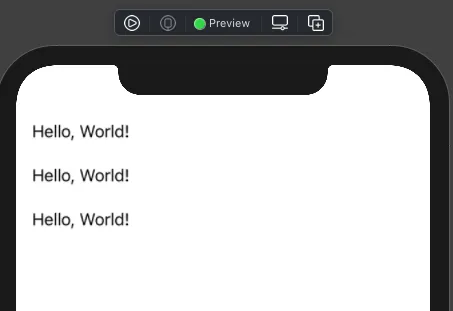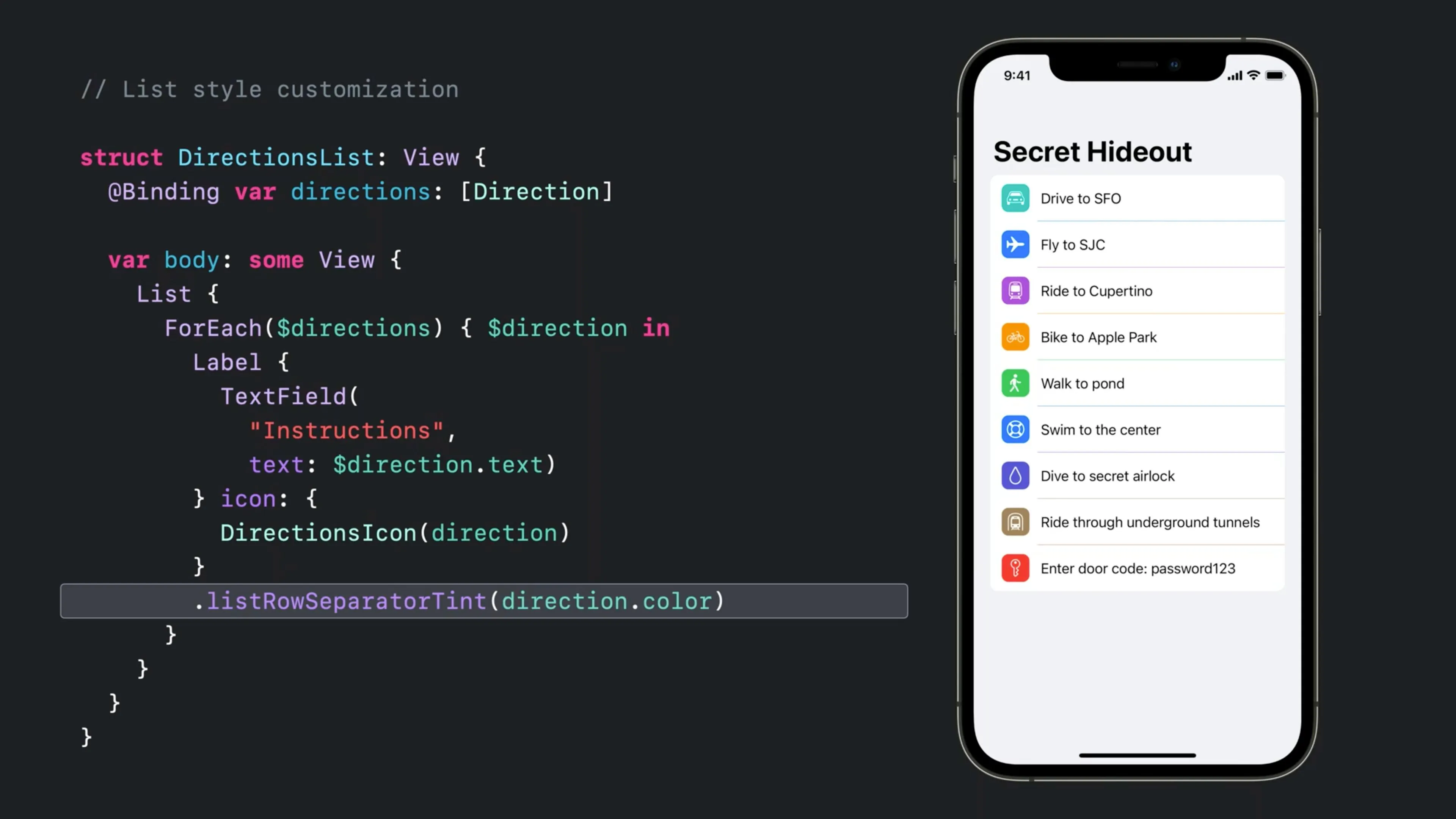UITableView().appearance().separatorStyle = .none
在iOS 13中这样做是有效的。然而,现在它不起作用了。有没有更新或者有什么办法可以让它起作用呢?谢谢 :)12个回答
47
- Asperi
7
4要使用
Color(UIColor.systemBackground)代替Color.white吗? - akmin3此外,在某些情况下,您可能希望应用负的边缘插图。
.listRowInsets(EdgeInsets(.init(top: -1, leading: -1, bottom: -1, trailing: -1)))。 - zrfrank2你如何在不修改插图的情况下实现这一点?移除所有填充会使列表看起来很糟糕。 - Jordan H
我在我的列表单元格中使用了按钮。添加后,按钮失去了高亮颜色。 - Tulon
如果您确实需要使用非零值的insets来使用.listRowInsets,该怎么办? - Petar
显示剩余2条评论
10
将@asperi、@akmin和@zrfrank的答案合并为一件事。 根据我的经验,List比LazyVStack更可靠和高效,因此,我仍然使用List来处理任何需要可靠性的复杂情况。
extension View {
func listRow() -> some View {
self.frame(maxWidth: .infinity, maxHeight: .infinity, alignment: .leading)
.listRowInsets(EdgeInsets(top: -1, leading: -1, bottom: -1, trailing: -1))
.background(Color(.systemBackground))
}
}
List {
Color.red
.listRow()
Color.green
.listRow()
}
- average Joe
4
如果你想要有列表分区,
LazyVStack 就不太适合了。 - Yiming Dong这对我有效。列表 + 一些视图(不是LazyVStack) - Brownsoo Han
在iOS 14上,它运行得非常好!没有LazyVStack,只有List + view。谢谢你!我快疯了! - Posa
我感到震惊的是,这在iOS 14上可以运行,但在iOS 15上似乎毫无作用,但事情就是这样。 - Robert Atkins
8
我如何创建一个适用于iOS 14和iOS 13的列表,它不显示分隔线和多余的边距。
struct NoButtonStyle: ButtonStyle {
func makeBody(configuration: Self.Configuration) -> some View {
configuration.label
}
}
struct ListWithoutSepatorsAndMargins<Content: View>: View {
let content: () -> Content
var body: some View {
if #available(iOS 14.0, *) {
ScrollView {
LazyVStack(spacing: 0) {
self.content()
}
.buttonStyle(NoButtonStyle())
}
} else {
List {
self.content()
}
.listStyle(PlainListStyle())
.buttonStyle(NoButtonStyle())
}
}
}
示例用法 -
ListWithoutSepatorsAndMargins {
ForEach(0..<5) { _ in
Text("Content")
}
}
如果列表中有更多的组件,请将它们包装在 Group 中。
ListWithoutSepatorsAndMargins {
Group {
self.groupSearchResults()
self.myGroups()
self.exploreGroups()
}
}
}
希望这篇文章能够帮到有需要的人,我在一个小问题上浪费了很多时间。苹果似乎在极力推动我们使用LazyVStack。
- Harish saini
6
2该解决方案是有害的,因为LazyVStack与List完全以不同的方式处理单元格。您可以检查滚动这些单元格时的CPU负载。如果单元格不仅仅是Text("hello test"),则会在滚动时看到峰值负载。 - Vivienne Fosh
滚动时CPU使用率会稍微增加,但随着事物的稳定,它会立即回落,这在UITableView中也会发生。我的应用程序中有相当重的单元格和非常大的列表,但它从未导致滚动卡顿或崩溃,我们迄今为止没有看到任何问题,但请自行决定是否使用! - Harish saini
@Lonkly,你为什么认为这可能是个问题? - Zapko
2@Zapko,你认为UIKit中StackView和TableView的主要区别是什么?与此相同的是List和LazyVStack。TableView会重用单元格,而LazyVStack则不会。因此,当您拥有更多的元素适合屏幕,并且布局比Text(“Content”)更复杂时,您将遇到极慢和延迟。因此,提供名为ListWithoutSeparators {}的解决方案并将其作为LazyVStack内部是非常有害的。 - Vivienne Fosh
2使用lazy vstack,您将失去其他List的好处,例如编辑状态、滑动删除手势等。 - Shengchalover
我已经使用List解决了这个问题,如果你想要List,请查看这里https://dev59.com/gFIG5IYBdhLWcg3w21eA#64028051。 - Harish saini
5
我在苹果开发者论坛上找到了这个简单的解决方案。它适用于14.4版本,对我有效:
List {
...
}.listStyle(SidebarListStyle())
这似乎在边缘周围添加了一点填充。如果对您来说是个问题,您可以尝试一些负填充。
- Mark Phillips
1
我认为这是目前最好的解决方案,非常优雅! - phuongzzz
3
根据Average Joe的答案,我最终得到了以下修改器:
struct ListSeparatorNone: ViewModifier {
var backgroundColor: Color = Color(.systemBackground)
func body(content: Content) -> some View {
content
.listRowInsets(EdgeInsets(top: -1, leading: 0, bottom: 0, trailing: 0))
.frame(maxWidth: .infinity, maxHeight: .infinity, alignment: .leading)
.background(backgroundColor)
}
}
视图扩展:
extension View {
func listSeparatorNone(backgroundColor: Color = Color(.systemBackground)) -> some View {
self.modifier(ListSeparatorNone(backgroundColor: backgroundColor))
}
}
使用示例:
List {
ForEach(viewModel.countries, id: \.self) { country in
Text(country)
.padding(.leading, 10)
}
.listSeparatorNone()
}
- Tzegenos
1
有时候有效,有时候无效。 - Michał Ziobro
0
这是我针对iOS 14的解决方案:
struct MyRowView: View {
var body: some View {
ZStack(alignment: .leading) {
// Background color of the Row. It will spread under the entire row.
Color(.systemBackground)
NavigationLink(destination: Text("Details")) {
EmptyView()
}
.opacity(0) // Hide the Disclosure Indicator
Text("Go to Details").padding(.leading)
}
// These 2 lines hide the row separators
.padding(.horizontal, -16) // Removes default horizontal padding
.padding(.vertical, -6) // Removes default vertical padding
}
}
封装的列表应该有这个修饰符
.listStyle(PlainListStyle())
与使用 LazyVStack 相比,这种解决方案的优点是您仍然可以使用 List 的编辑功能。
此解决方案不幸依赖于硬编码的值,以删除每行的系统默认填充。希望 SwiftUI 3.0 提供简单的 .separatorStyle(.none) 和 .accessoryType(.none) 修饰符。
去除披露指示器的代码来自:https://www.appcoda.com/hide-disclosure-indicator-swiftui-list/
- Joss
0
感谢 @asperi、@akmin、@zrfrank 和 @averageJoe 的回答。
这里是另一种在 iOS 14 和 15 中有效的改进方法。
这里是另一种在 iOS 14 和 15 中有效的改进方法。
extension View {
func hideListRowSeperator() -> some View {
if #available(iOS 15, *) {
return AnyView(self.listRowSeparator(.hidden))
} else {
return AnyView(self.frame(maxWidth: .infinity, maxHeight: .infinity, alignment: .leading)
.listRowInsets(EdgeInsets(top: -1, leading: -1, bottom: -1, trailing: -1))
.background(Color(.systemBackground)))
}
}
}
使用示例
var body: some View {
List {
ForEach(0..<3) { _ in
Text("Hello, World!")
.padding(.leading)
.hideListRowSeperator()
}
}
.listStyle(.plain)
}
- Jerome Li
0
更新:
我找到了一个解决方案,可以在iOS 13和iOS 14上运行,并提供一个简单的列表,并在iOS上使用List。
struct ListWithoutSepatorsAndMargins<Content>: View where Content: View {
let content: () -> Content
init(@ViewBuilder content: @escaping () -> Content) {
self.content = content
}
var body: some View {
List {
self.content()
.frame(maxWidth: .infinity, maxHeight: .infinity, alignment: .center)
.listRowInsets(EdgeInsets())
.background(Color.white)
}
.listStyle(PlainListStyle())
.buttonStyle(NoButtonStyle())
}
}
struct NoButtonStyle: ButtonStyle {
func makeBody(configuration: Self.Configuration) -> some View {
configuration.label
}
在 SceneDelegate.swift 中执行以下操作,以删除单元格的默认灰色选择:
func scene(_ scene: UIScene, willConnectTo session: UISceneSession, options connectionOptions: UIScene.ConnectionOptions) {
UITableView.appearance().separatorStyle = .none
UITableView.appearance().allowsSelection = false
.......
我们可以这样使用它
ListWithoutSepatorsAndMargins {
ForEach(0..<5) { _ in
Text("Content")
}
}
ListWithoutSepatorsAndMargins {
Group {
self.groupSearchResults()
self.myGroups()
self.exploreGroups()
}
}
}
- Harish saini
5
那我们应该在哪里找到
SceneDelegate? - Ovi Trif1在你的应用程序启动时添加第一段被执行的代码。 - Harish saini
在较新版本的iOS中,我发现单元格之间有默认的间距,可以通过以下方法去除。 - Harish saini
`List { self.content()
.frame(maxWidth: .infinity, maxHeight: .infinity, alignment: .center)
.listRowInsets(EdgeInsets())
.background(Color.white) }
.listStyle(PlainListStyle())
.buttonStyle(NoButtonStyle())
.environment(.defaultMinListRowHeight, 1)` - Harish saini
从之前的解决方案中删除额外的
.environment(\.defaultMinListRowHeight, 1)。 - Harish saini0
如果您的单元格数量不多,因此不需要依赖LazyVStack来提高性能,那么您可以使用ScrollView + VStack:
ScrollView {
VStack {
Row1()
Row2()
Row3()
}
}
- Senseful
网页内容由stack overflow 提供, 点击上面的可以查看英文原文,
原文链接
原文链接


UITableView了...也没有钩子)) - Asperi